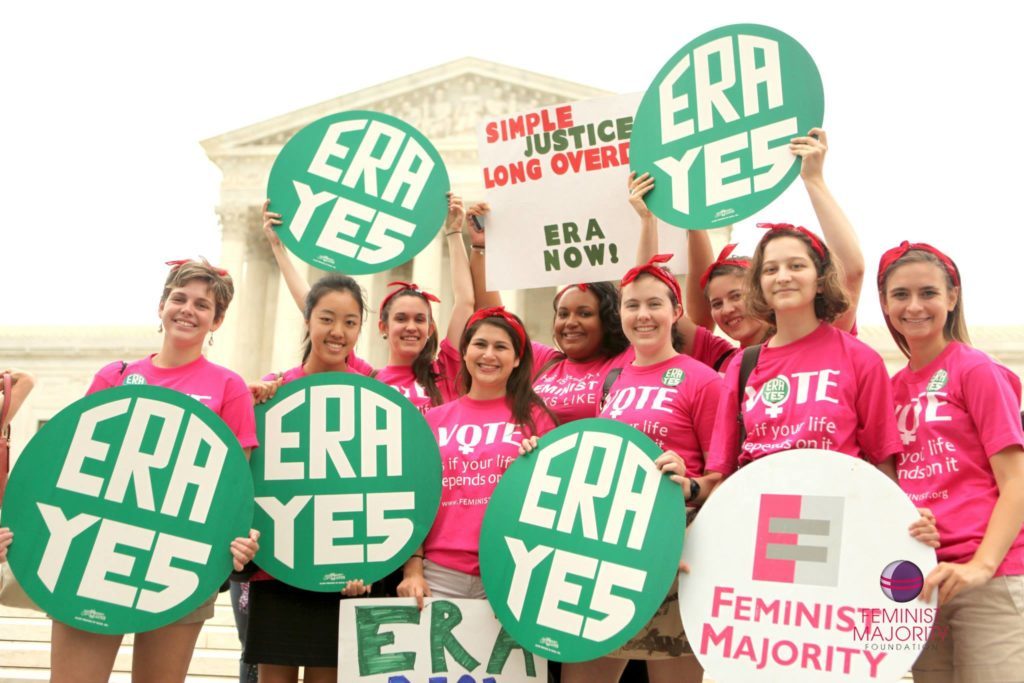On November 13, the House Judiciary Committee passed H.J. Res 79, a resolution that would remove the arbitrary time limit for the ratification of the Equal Rights Amendment (ERA).

House Judiciary Chairman Jerrold Nadler (D-NY) introduced the resolution, which was originally introduced by Rep. Jackie Speier (D-CA), for markup at a hearing on Capitol Hill. A companion resolution in the Senate has been introduced by Senators Lisa Murkowski (R-AK) and Ben Cardin (D-MD).
The resolution has rapidly gained momentum in the days since a pro-ERA majority was elected to the Virginia state legislature earlier this month. State legislators have pledged to bring the ERA to the Virginia Assembly for passage in early 2020, making it the 38th and final state necessary for ratification.
This is a crucial moment for women’s equality: Victory for the ERA is in sight.
The Equal Rights Amendment is just as necessary now as it was when the amendment first passed out of Congress in 1972. Without an ERA, progress for girls and women remains slow, uneven and subject to reversal by state legislatures, Congress and presidential administrations hostile to women’s equality.
As we have written in Ms.:
“Without an Equal Rights Amendment, all the federal legislative gains over the past four decades – from Title IX to the Pregnancy Discrimination Act to pay equity to the Violence Against Women Act and much more – are just that – legislative. They can be wiped out by hostile state lawmakers, the Congress or Supreme Court, or chipped away slowly and insidiously.”
When we wrote this in our Winter 2015 issue, we could not have fathomed the extent of the setbacks we have endured since Trump’s election.
A short history of the ERA
The Equal Rights Amendment was first authored by Alice Paul, a leading suffragist, and first introduced in Congress in 1923, shortly after American women fought and won the right to vote. It was re-introduced in every congressional session until it passed in 1972—almost half a century later. Like all constitutional amendments, after passing the House of Representatives and the Senate with the required two-thirds vote, the ERA was sent to the states for ratification. Thirty-eight state legislatures must vote to ratify an amendment before it is added to the Constitution.
Before being sent to the states, however, an arbitrary time limit of seven years was added to the preamble of the Amendment. States did not vote on the arbitrary time limit included in the preamble. States were asked to ratify and add to the Constitution the following language: “Equality of Rights under the law shall not be denied or abridged by the United States or by any State on account of sex.”
The timeline was later extended until June 1982, following demonstrations by tens of thousands of women’s rights supporters in the streets of Washington, D.C. But the ERA faced intense opposition from business interests, including the insurance industry, the Chamber of Commerce, and the National Association of Manufacturers. When the extension expired, only 35 of the necessary 38 states had ratified.
In the past three years, in the wake of one attack after another on women’s rights by the Trump administration and hostile state legislatures, a renewed sense of urgency to pass the ERA has led to ratification by two additional states—Nevada in 2017 as the 36th and Illinois in 2018 as the 37th state to ratify. Now, it is very likely that Virginia will become the 38th and final state needed to ratify the Equal Rights Amendment.
“The need for equal protection under the Constitution is still as urgent as ever today as it was when the ERA first went to the states for ratification in 1972,” said Eleanor Smeal, president of Feminist Majority. “We have never stopped working to get three-fourths of the states to ratify and that day is swiftly approaching.”
What’s next?
Though the fight is certainly not over, victory is finally in sight. The Equal Rights Amendment enjoys overwhelming support – 94 percent – from the American public. Feminist legislators in Virginia have promised that the ERA is a priority in the coming year, becoming the final state needed for ratification. The action by the Judiciary Committee to remove the time limit is a critical step. What’s more, Constitutional law scholars have concluded the time limit is “not binding” and the Congressional Research Service has called the time limit “far from being sacrosanct,” since Congress granted an earlier extension of the timeline.
“We will ratify the Equal Rights Amendment. The question is no longer if, but when,” said Senator Ben Cardin (D-MD), who is sponsoring the Senate version of HJ Res 79. He continued, “Most Americans are surprised to learn that the ERA is not already part of the U.S. Constitution, so it’s high time the Congress step up and help make that happen.”
Today’s mark-up in the full House Judiciary Committee is an important next step to recognizing and respecting women as equal partners in our nation and its laws.
“Equality of rights under the law” is a core American principle that must clearly be written into the Constitution so that women’s rights are guaranteed and cannot be reversed or overturned. The ERA will cement the gains women have made and pave the way for more progress. The ERA is long overdue. It is time to put women in the Constitution.
Ms. has been reporting on the fight for the ERA since our earliest days. Now that we are in the homestretch, we know that our storytelling and insightful reporting in the days, weeks and months ahead will be critical in this fight.
But we can’t do it without you. Will you consider supporting our ongoing reporting and truth-telling with a tax-deductible donation today?





